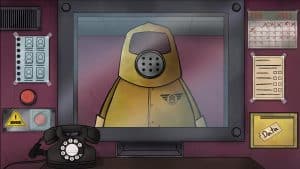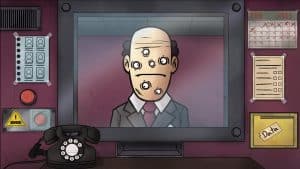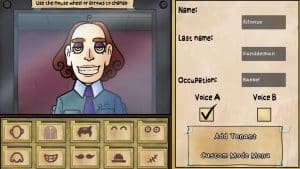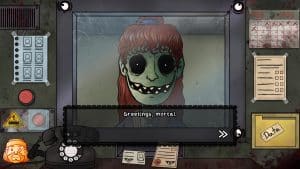That’s not my Neighbor
Related Games
Description
🔥 What is That’s Not My Neighbor for PC
That’s Not My Neighbor is a psychological horror simulation game developed by Nacho Sama that combines eerie social deduction with meticulous observation. Set in a grim alternate version of the 1950s, the game places players in the role of a building security clerk tasked with a deceptively simple job: screening tenants as they enter their apartment complex to ensure none of them are impostors terrifying entities capable of perfectly mimicking humans. However, as days pass, it becomes clear that something far more sinister lies beneath the surface of this strange, controlled world.
Players sit behind a security desk equipped with vintage cameras, file folders, and verification tools that evoke the bureaucratic tension of Papers, Please but through a horror lens. You must check each visitor’s ID, photo, and behavior against official records, watching for inconsistencies or odd gestures that reveal an impostor. Every decision carries heavy consequences, as failing to identify an impostor or wrongly accusing a real tenant can have unsettling and sometimes fatal results.
That’s Not My Neighbor transforms mundane administrative work into a psychological test of awareness, paranoia, and morality. The deeper you go, the more the world unravels, revealing disturbing hints about the government, the tenants, and even your own identity. Its slow tension, subtle storytelling, and uncanny atmosphere make it one of the most unique indie horror experiences in recent years.
👉 Features of That’s Not My Neighbor
Meticulous Verification Mechanics
The core gameplay revolves around verifying tenants’ identities through observation, paperwork, and environmental cues. Each person you inspect brings small variations in speech, tone, and facial expression, forcing you to pay close attention to even the tiniest detail. Mistakes are rarely forgiven, and the line between “human” and “impostor” blurs as the days drag on, enhancing the game’s oppressive tension.
The system rewards pattern recognition and calm under pressure. As you grow familiar with the residents, the impostors become more subtle, introducing behavioral tricks and mimicking speech patterns. The further you progress, the more complex and unpredictable these encounters become.
Atmospheric Horror Without Jumpscares
Rather than relying on sudden loud noises or predictable frights, That’s Not My Neighbor uses atmosphere and implication to create dread. The sterile lighting, soft background hum, and quiet monotony of your job slowly become unbearable as you start questioning what is real. It’s a masterclass in tension built through stillness, silence, and tiny distortions of the familiar.
Every knock at the door or slow turn of a tenant’s head becomes unsettling, and the game’s ability to make the ordinary feel horrifying is what sets it apart. You’re trapped in routine, yet you never feel safe.
Subtle Narrative and Worldbuilding
The story unfolds in fragments through government memos, suspicious notes, and unsettling interactions with residents. It doesn’t spoon-feed information but instead encourages players to piece together what’s happening through observation and inference. This fragmented storytelling gives the game a Kafkaesque quality every answer only raises more disturbing questions.
Over time, themes of conformity, control, and identity emerge, turning the act of checking IDs into a metaphor for surveillance and dehumanization. You begin to realize that perhaps the impostors aren’t the only monsters in this building.
Unique Hand-Drawn Visual Style
Every frame of That’s Not My Neighbor is rendered in a distinctive hand-drawn aesthetic that mixes mid-century illustration with uncanny distortion. Characters look realistic at first glance, but their subtle imperfections the slightly wrong proportions, the too-wide smiles, the vacant eyes build unease with every encounter.
This deliberate art direction makes the impostors terrifying not because they are grotesque, but because they are almost normal. The world feels lived-in, yet fundamentally wrong.
Psychological Pressure System
Beyond simple identification, the game constantly tests your composure. The longer you play, the more the screen distorts, the music shifts, and the rules begin to blur. Your character’s sanity becomes another invisible meter, subtly affected by your choices. Wrong calls can haunt you, literally and psychologically, as voices, shadows, and memories begin to invade the workspace.
This system ensures that no two playthroughs feel the same, as paranoia seeps into the player’s decision-making and makes even the most routine check feel nerve-racking.
Gameplay
Observation and Analysis
Every shift begins with you seated at your inspection desk, facing a steady stream of residents waiting to be let into the building. You’ll check their documentation, compare faces and signatures, and decide whether they are legitimate or impostors. The challenge lies in the tiny discrepancies a slightly altered photograph, a flicker of an expression, or an unnatural tone of voice.
Each interaction builds tension, especially as impostors start to imitate genuine residents with alarming accuracy. Success relies not only on noticing the differences but also on trusting your instincts amid rising uncertainty.
Escalating Difficulty and Rules
As the game progresses, new mechanics and regulations are introduced, forcing you to adapt. One day you might be required to confirm fingerprints, another day to verify authorization codes or match phone records. Each new rule increases the workload while also deepening the psychological fatigue.
The escalation is gradual but relentless, creating an authentic sense of bureaucratic horror. You feel trapped in an endless system of control and fear, where the smallest slip can bring ruin.
Narrative Events and Multiple Endings
While your daily duties form the core loop, strange events gradually disrupt the routine. Residents start acting differently, and government inspectors appear with cryptic instructions. Depending on how you handle specific encounters and moral choices, the story branches into multiple endings that explore different facets of the truth.
Some endings reveal disturbing conspiracies, while others focus on personal guilt or acceptance. Each route encourages replayability and rewards attention to detail, as small actions can drastically alter the outcome.
Graphics
Vintage Hand-Drawn Aesthetic
The game’s visual identity draws heavily from 1950s animation and propaganda art, with muted colors, thick outlines, and deliberate imperfections. This retro aesthetic contrasts sharply with the game’s unsettling subject matter, creating a disturbing harmony between nostalgia and fear.
Objects look familiar but slightly exaggerated, and human faces carry just enough irregularity to make you uncomfortable. The attention to lighting and texture gives the entire game a tactile quality that makes the horror feel grounded.
Visual Distortion and Psychological Effects
As paranoia increases, the visuals subtly distort: lights flicker, faces warp, and the static on monitors grows louder. These graphical effects serve both narrative and gameplay functions, communicating the protagonist’s deteriorating mental state while increasing player anxiety.
The result is a visual experience that mirrors the descent into madness, pulling the player deeper into the character’s fragile mind without ever breaking immersion.
Interface and Presentation
The minimalist interface contributes to immersion, keeping focus on the faces and documents you must inspect. Old typewriter fonts, grainy textures, and analog-style buttons make every interaction feel tactile and immersive. Even menu transitions are designed to mimic the mechanical clunk of outdated technology.
This attention to presentation ensures that every part of the game, from UI to background noise, reinforces its claustrophobic atmosphere.
Pros and Cons
✔️ Pros
- Unique blend of bureaucratic gameplay and psychological horror that feels deeply original
- Distinctive hand-drawn art style that builds unease without resorting to gore
- Deeply immersive sound design and subtle worldbuilding that reward observation
- Multiple endings encourage replayability and moral reflection
- Atmospheric horror that relies on tension rather than cheap scares
❌ Cons
- Slow pacing may frustrate players seeking more immediate action
- Limited interactivity outside the desk can feel restrictive
- Ambiguous storytelling might leave some players confused or unsatisfied
ℹ️ Game information
Release Date: 11/03/2025
Update Date: 31/10/2025
Version: v1.1.0.2
Genre: Adventure / Simulation
Platform: PC
Language: ![]()
![]()
![]()
![]()
![]()
![]()
![]()
![]()
Weight: 1 GB
Additional info: New version includes all DLCs to date
⭐ Installation Instructions
- The game is fully complete, you just need to install it, so there is no need to unpack it or download it from other sources.
- Just run the That’s not my Neighbor.exe installation file.
- Simply launch the game from shortcut desktop.
⚙️ System Requirements
✅ Minimum:
- OS: Windows 10 64-bit
- Processor: Intel Core i5-1300F
- Memory: 2 GB RAM
- Graphics: ATI FireMV 2400 PCIe
- DirectX: Version 11
- Network: Broadband Internet connection
- Storage: 1 GB available space
Images






